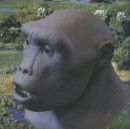



He called it Australopithecus africanus, the Southern Ape from Africa, wrote up the discovery and sent it to Nature. It was published in the face of strong opposition1.
None of the London-based authorities of the day believed the report, from a relative unknown working in an obscure part of the world. They were convinced that Dart had found a fossil monkey.
Dart was eventually vindicated, and Australopithecus africanus stands at the beginning of the science now known as palaeoanthropology - the study of human origins and evolution.
Dart's discovery came at a time when all we knew of human origins were the almost-human Neanderthals, 'Java Man' (later Homo erectus) and Piltdown Man (later exposed as a fraud).
After Dart came such scientists as Robert Broom and Louis Leakey. With associates and successors, they discovered a variety of ape-men and near-humans that lived in southern and eastern Africa between five million and two million years ago, when fully fledged members of our own genus, Homo, first appeared.
This week Nature publishes a report to match that of Dart2,3: a strange, new skull, from an unexpected place, reported by little-known scientists, which will have large and largely unpredictable consequences for our understanding of human origins.
Gap plugged
The newfound skull is between six and seven million years old, and represents the earliest member of the human family so far discovered. The next-oldest hominids come from Ethiopia4 and, more controversially, Kenya5, and are between five and six million years old. A hominid is a member of the human family, as distinct from chimpanzees and other apes.
Like Dart's finding 77 years ago, the new find breaks the mould by having been discovered where few thought to look: this time in the inhospitable heart of northern Chad, on the southern fringes of the Sahara. This is where the stories diverge.
Dart's discovery was met with scepticism. The skull found by Michel Brunet and Patrick Vignaud of the University of Poitiers, France, and their colleagues in the international Mission Paleoanthropologique Franco-Tchadienne (MPFT) will be greeted with acclaim.
Dan Lieberman of Harvard University, one of the palaeontologists who have seen the fossil, says that it will have an impact on the field like 'a small nuclear bomb'. I'd argue that this is the most important hominid discovery in living memory.
Nicknamed 'Toumaļ' - a local name for a child born perilously close to the start of the dry season - the skull's importance is its vintage. Toumaļ is from a crucial interval in human evolution about which virtually nothing is known.
Ten million years ago, the world was full of apes; five million years ago, the first good records of hominids appear4,5. Between these two benchmarks, the human lineage diverged from that leading to chimpanzees. And yet the entire record of human evolution in this interval is frustratingly sparse - a few fragments remain, all of which can be fitted into a shoebox.
The wealth of information to be gained from Toumaļ, properly known as Sahelanthropus tchadensis, and an accompanying collection of jaws should enrich our understanding of human origins in ways that we can barely yet appreciate.
Face facts
This short new face of the past contains an odd mixture of primitive and advanced features. Toumaļ's braincase is very ape-like, but his or her canines are small, more like those of a human. Toumaļ has prominent brow ridges of the kind seen only in our own genus, Homo.
Does this mean that Toumaļ represents a deep and direct ancestor of Homo, side-stepping the various African 'ape-men' from between five million and two million years ago, discovered over the past 70 years? Bernard Wood of George Washington University in Washington DC thinks not.
Wood suggests that Toumaļ's combination of features represents a small sample of a huge and hitherto unsuspected diversity of fossil hominids, way back in the past."
References
- 1. Dart, R. A.The Man-Ape of South Africa. Nature, 115, 195 - 199, (1925).
- 2. Brunet, M. et al. A new hominid from the Upper Miocene of Chad, Central Africa. Nature, 418, 145 - 151, (2002).
- 3. Vignaud, P. et al . Geology and palaeontology of the Upper Miocene Toros-Menalla hominid locality, Chad. Nature, 418, 152 - 155, (2002).
- 4. Haile-Selassie, Y.Late Miocene hominids from the Middle Awash, Ethiopia. Nature, 412, 178 - 181, (2001).
- 5. Senut, B. et al . Premier hominide du Miocene (formation de Lukeino, Kenya). . Les Comptes rendus de l'Academie des sciences, 332, 137 - 144, (2001).
June 4, 2005
MORE (Human Origins)
Nature News Service


Sahelanthropus tchadensis:
"the most important hominid discovery in living memory".
© M.P.F.T.